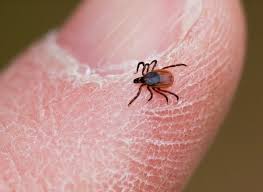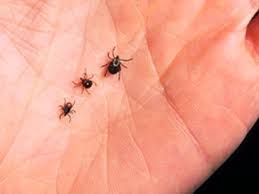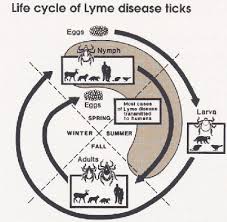Disarray And Disenchantment, Amid The Deer Ticks
- Director: Derick Martini
- Genre: Family comedy-drama
- Running time: 94 minutes
Rated R: profanity, sexual situations, fist fights, gun threats
NPR.org, April 9, 2009 · Midway though Lymelife, an unhappily drunk suburban mom drops the family's Monopoly set, and little green plastic houses scatter.
And because the movie has already offered vignettes of tract homes, not to mention close-ups of miniature abodes in a real estate office, there's just one conclusion to be drawn: Cookie-cutter houses are the problem.
Longtime couples drifting apart? Sexual awakening a drag? Teenagers growing to hate their parents? Blame it on the mini-mansions.
Director Derick Martini does present some other suburban afflictions, notably the one mentioned in the film's title: Lyme disease threatens late-'70s Long Island, where Brenda (Jill Hennessy) tapes shut the cuffs of 15-year-old son Scott (Rory Culkin), and where their neighbor Charlie (Timothy Hutton) suffers long-term consequences after a tick bite.
Charlie is also enduring unemployment and depression, and perhaps hallucinations. (Is he the only one who sees that ominous deer prowling the neighborhood, possibly carrying Lyme-diseased ticks?)
Plus, Charlie knows that his wife, Melissa (Cynthia Nixon), is having an affair with her boss, the ambitious residential-property developer named Mickey (Alec Baldwin) who is Brenda's husband. Mickey tells his sons that Long Island real estate will soon make him a millionaire; Brenda can't stop recalling how much happier they were back in Queens.
Martini scripted this proficient but mostly unsurprising movie with his brother Steven, and the two have acknowledged that it's autobiographical. So naturally the story turns on the younger generation — especially on Scott.
Regularly bullied at school, Scott takes lessons in macho from his obnoxious father and his older brother Jim (Kieran Culkin), who is home for a visit before beginning a stint in the military. But Scott is tormented less by other guys than by his seemingly hopeless love for longtime friend Adrianna (Emma Roberts), who lives next door. She is, of course, the daughter of Melissa and Charlie.
Sly Adrianna looks out for bland Scott, but she tells him she prefers to date older boys. Still, the two have a crucial bond: the emotional wreckage strewn by their parents' entanglements.
While the movie focuses on Scott and his idealized crush, Hutton and Baldwin give the most colorful performances. Charlie and Mickey's near-confrontation in a bar shows how much more compelling Lymelife could have been if the Martinis had downplayed the coming-of-age-kids stuff.
Conventionally, the director sets the period with TV reports (the seizure of the U.S. Embassy in Tehran) and pop-culture fandom (Scott wants to be Han Solo). The music, which ranges from Boston and Bad Company to Frank Sinatra, is less chronologically specific, and sometimes kind of confusing.
The movie concludes with tracking shots of homes, and a foreboding reflection in a new house's glass exterior. Yet for all its emphasis on suburbia and its discontents, Lymelife never quite convinces that its story's environs are essential — or even all that interesting.
The emergence of Lyme disease in Canada
Nicholas H. Ogden, DPhil, L. Robbin Lindsay, PhD, Muhammad Morshed, PhD,
Paul N. Sockett, PhD and Harvey Artsob, PhD
Canadian Medical Association Journal, 2009 Jun 9;180(12):1221-4.
Free, full text here:
http://www.cmaj.ca/cgi/
http://dx.doi.org/10.1503/
Review
Lyme disease, caused by the bacterium Borrelia burgdorferi and
transmitted by tick vectors, is the most commonly reported vector-borne
disease in the temperate zone. More than 20 000 cases are recorded
annually in the United States. In about 80% of cases, early Lyme disease
is characterized by a skin lesion, erythema migrans, which expands to a
diameter of more than 5 cm from the site of the tick bite. If left
untreated, the disease can progress to early disseminated Lyme disease
with neurologic (facial palsy, meningitis and meningoradiculoneuritis,
also known as Bannwarth syndrome) and cardiac (usually atrioventricular
block, sometimes with myopericarditis) involvement, and then to late
disseminated Lyme disease with neurologic manifestations (peripheral
neuropathy or encephalomyelitis) and Lyme arthritis.
B. burgdorferi is transmitted by ticks, which feed on wildlife reservoir
hosts of the pathogen, particularly rodents and birds. Ixodes
scapularis, the blacklegged tick (Figure 1), is the main vector in
eastern and central North America. Ixodes pacificus, the western
blacklegged tick, is the main vector west of the Rocky Mountains. Both
tick species are indiscriminate in their choice of host and will feed on
humans; as such, they can transmit pathogens from wildlife to humans.
Recent studies have suggested that the risk of exposure to Lyme disease
is emerging in Canada because the range of I. scapularis is expanding, a
process that is predicted to accelerate with climate change. Here we
review the available and emerging surveillance information and discuss
its relevance to the early diagnosis and prevention of Lyme disease. We
based this review on a search of the MEDLINE database using the key
words "Lyme," "Ixodes " and "Canada."















